Menu
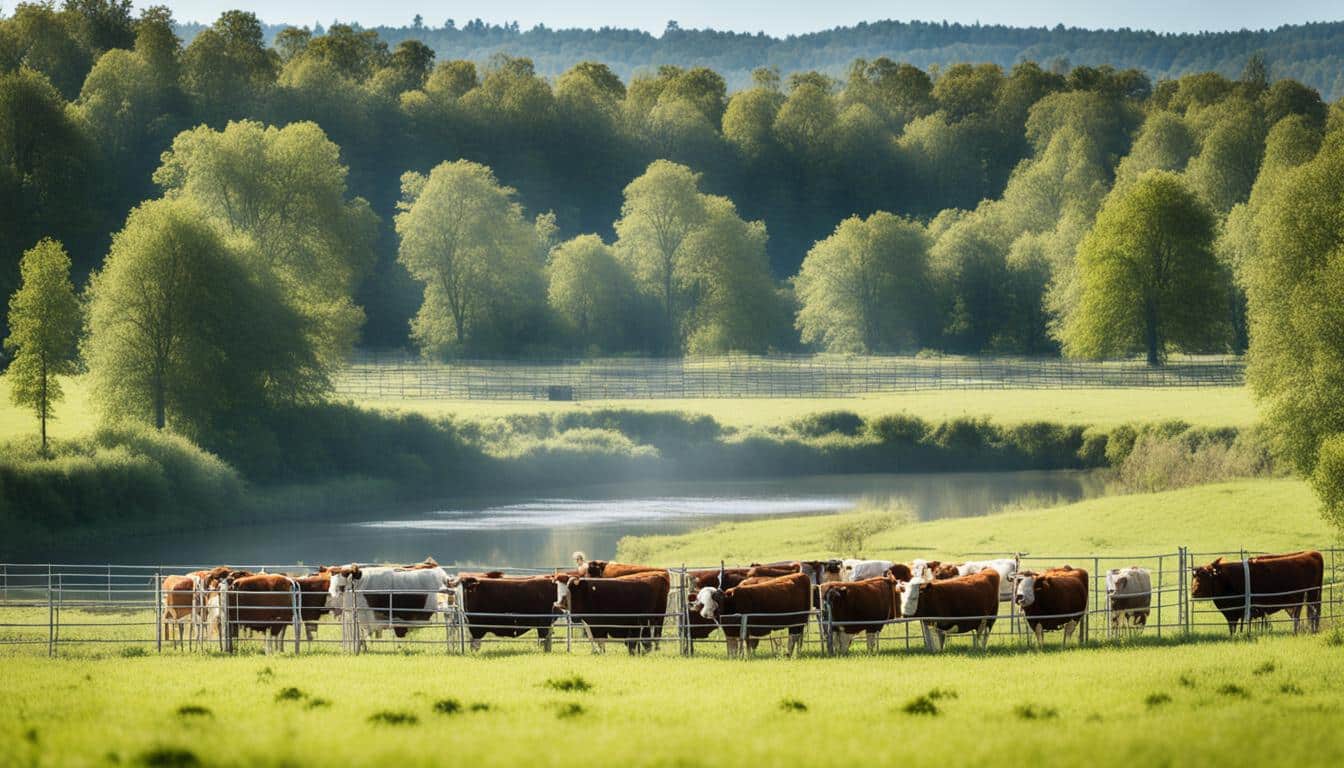
Did you know, livestock makes up almost 40% of the global agriculture value? It supports nearly 1.3 billion people. With our world’s population heading towards 10 billion by 2050, we face a big issue. We need to meet the growing need for animal products while protecting our resources and the environment.
Animal health is key in managing livestock sustainably. Good care and health practices help lower the impact on the environment. They also reduce the emissions coming from the animals. The FAO found that using these practices could cut down emissions by 30%.
Livestock farming contributes over 7.1 gigatons (GT) of CO2 equivalent emissions yearly. This is about 14.5% of all human-made greenhouse gases. But, by managing livestock in a sustainable way, we can reduce this impact. This includes methods like ecological farming and good animal care.
Livestock makes up 40% of the world’s farming value. Sustainable management is key. It helps feed a growing middle class while protecting the environment. This means using methods that are good for nature, help ecosystems last long, are fair for people, and make sense economically for farmers.
One big part of sustainable farming is lessening harm to the environment. This includes things like rotating where animals graze and better ways to deal with their droppings. These actions cut down on the methane they produce, a powerful greenhouse gas.
Better livestock care, improved breeding, and what we feed animals make farming more efficient. This means fewer animals are needed to make the same amount of meat or dairy. So, there’s less impact on the environment.
Modern agriculture is also moving towards using less antibiotics and chemicals. This helps stop the problem of these medicines not working. New tech in looking after cattle, like digital aids and automated systems, also makes things better for the animals themselves.
Across the planet, people are turning more towards sustainable livestock ways. They’re fighting big issues such as cutting down forests, eroding soil, and polluting water. A big effort in Kazakhstan, supported by the World Bank, is trying to make beef production better while using less land and producing fewer greenhouse gases.
Many countries are showing their dedication to being green. Mexico is making small and medium-sized farms use clean energy. Ethiopia and Bangladesh are spending a lot on eco benefits. And Uruguay is leading in smart livestock techniques. All these examples prove that local, unique efforts are key to making livestock better for our planet.
Below is a table highlighting some initiatives and their impacts:
| Project Location | Initiative | Impact |
|---|---|---|
| Kazakhstan | World Bank Program | Increased beef production with GHG emission reduction |
| Mexico | Eco-Friendly Energy Adoption | Reduction of 3,388,670 tons of CO2 |
| Uruguay | Climate-Smart Practices | Reduced fertiliser usage, conserved water, improved carbon sequestration |
| Vietnam | Technology & Training | Benefited over 151,000 livestock farmers |
| Colombia | Sustainable Cattle Ranching | 1.05 million tons of CO2 equivalent captured, biodiversity conserved |
The wellbeing of farm animals plays a key role in sustainable farming. Healthy livestock not only produce more but also reduce harm to the environment. They support efforts in managing a greener farming approach. This leads to better growth and productivity while using fewer resources.
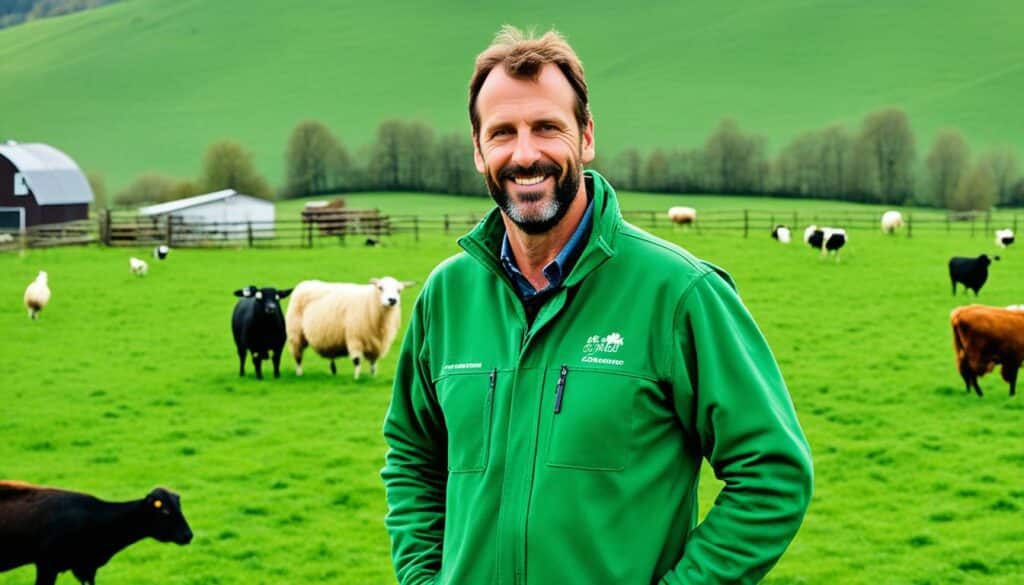
Good animal health helps lower greenhouse gas emissions. For instance, tackling diseases like Neosporosis in cattle can cut Scotland’s emissions by 4.5%. With animals contributing significantly to these emissions, effective disease control is critical. Managing diseases also decreases the number of unproductive animals, reducing their environmental impact. Following sustainable guidelines suggested by the FAO might reduce emissions by 30%.
High disease and death rates in livestock lead to big economic losses and more environmental harm. Preventing diseases and ensuring animal welfare cuts down premature animal losses. This results in better resource use and lower emissions like methane from livestock. Places like Argentina and Uruguay show how focusing on animal health can reduce CO2 emissions and boost productivity.
Green livestock management is vital for both animal wellbeing and a sustainable farm future. It ensures that cutting greenhouse gas emissions is a vital part of farming. Ongoing research and new farming methods offer hope for sustainable farming.
Getting animal nutrition right is key for looking after our environment. By changing what animals eat, we use more eco-friendly elements in their food. These changes help animals stay healthy and grow well. They also help us take better care of our land and natural resources.
Changing animal diets can be a big help in sustainable farming. For example, adding certain fats to cattle food cuts down on methane. This step is good for the planet, making sure farming is kinder to our environment. People who study animal nutrition are always working to make feeds better. They aim to use less food while growing healthy animals. This saves money and reduces the impact on the environment.
Using by-products in animal feed is smart for the earth. For instance, adding sugar beet molasses to cow feed can lower harmful gas emissions. This helps cut down on waste and looks after the planet. It’s a clever way to use leftovers from making food for animals. This not only makes farming more sustainable but also saves natural resources. Making sure animals eat well can help in making food in a way that uses less resources.
The American Feed Industry Association (AFIA) and the Institute for Feed Education & Research (IFEEDER) are working hard on this. They aim to improve how we feed animals in a way that’s better for our planet. Their work is important for making livestock farming greener.
Reducing methane from livestock is vital for eco-farming and better animal health. New products, like special meals and vaccines, are helping a lot.
The supplement 3-NOP is great at lowering cow methane. It can cut emissions by 30%. Adding fats to cow food, like tallow and sunflower seeds, can also help, reducing gases by 14% to 33%.
Putting food scraps in animal meals, such as sugar beet molasses, helps too. It lowers the need for lots of grain, which is hard on the environment. These changes could really help the whole farming industry be better for the planet.
New Zealand is working on special shots for cows that target bad gut bacteria. These vaccines could cut methane a lot. They show how looking after animal health can also help the Earth. Keeping up this work, with lots of studies and new ideas, is key for farming that doesn’t harm our planet.
The European Union is a leader in making new things to cut down on cow gas. They’re looking at tiny life forms and stuff from plants. These ideas could help lower methane and keep cows healthy.
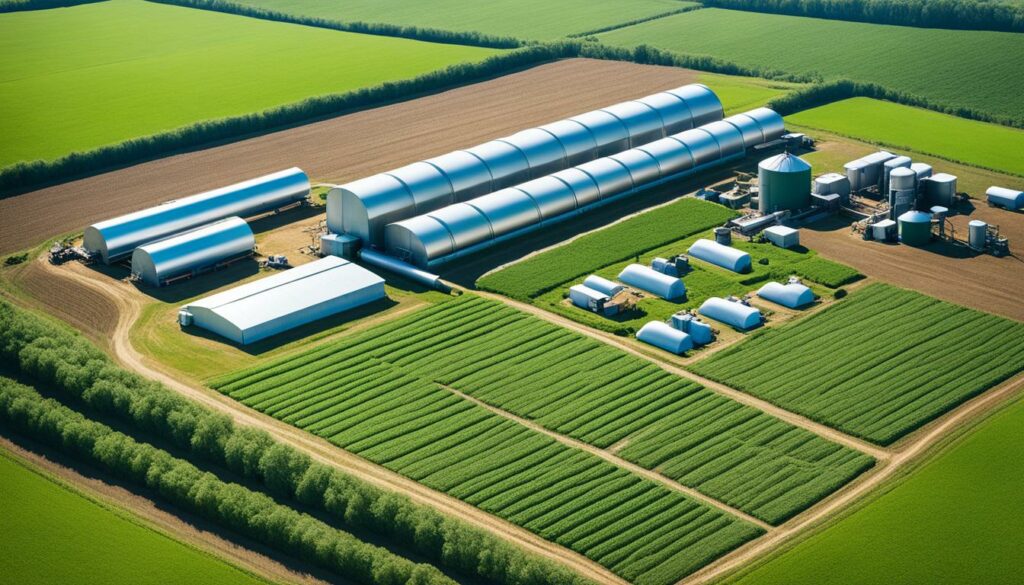
| Innovation | Impact on Methane Reduction | Additional Benefits |
|---|---|---|
| 3-NOP Supplement | Up to 30% reduction | Improved dairy cow productivity |
| Dietary Changes (e.g., Sunflower Oil) | 14% to 33% reduction | Enhanced animal nutrition |
| Vaccine Development | Significant reduction | Healthier livestock |
| Food By-products (e.g., Sugar Beet Molasses) | Reduced reliance on grain | Cost-effective feed options |
Sustainable livestock management aims to boost output without harming the planet. It supports around 1.3 billion people and makes up 40% of farming’s global value. So, using sustainable methods is crucial.
To do it right, we focus on what animals eat, cut down on methane, and manage waste well. Practices like moving animals from field to field and handling their waste carefully cut down on harmful gases. This way, we support a healthy planet and still get a lot of food. It’s all about caring and smart farming.
Also, picking the right animals and feeding them better can mean we need fewer. This makes farming more efficient. Good food for animals means they’re healthier and work better for us.
Adding trees where animals live is great for them and the planet. It helps keep the land healthy and stores carbon away. This way of farming connects well with nature and has big benefits. Also, choosing to eat more plants and less meat can really help cut down the harm farming does.
| Technique | Benefits | Environmental Impact |
|---|---|---|
| Rotational Grazing | Improves pasture health | Reduces methane emissions |
| Improved Manure Management | Efficient nutrient recycling | Reduces GHG emissions |
| Selective Breeding | Enhances animal productivity | Lessens the number of livestock |
| Silvopasture | Integrates trees and livestock | Sequesters carbon |
| Plant-Based Diets | Provides alternatives to meat | Minimises environmental burden |
Technology is changing how we manage livestock, making it greener. Only 12% of dairy farms use robots now. But, this is set to grow to 20% in the next five years. This change shows how important digital tools are in farming.
The past eight to ten years have seen big technological steps in farming. These new tools make farmers more productive and efficient. They also help keep better checks on the animals and the environment. Allflex and Danish farm players work together to monitor animals. They do this to use resources better and reduce emissions from farming.
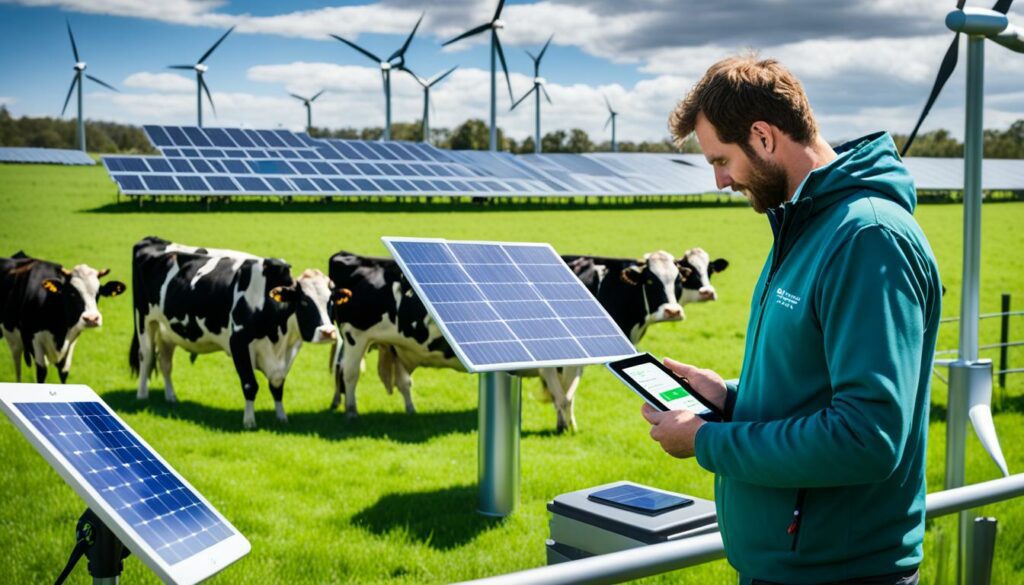
Now, farmers can keep good track of money spent, manage workers better, and look after their animals well. These tech tools are good for daily farm jobs and for the environment. Livestock farming causes a lot of greenhouse gas emissions. So, using high-tech solutions is very important.
| Current Usage | Expected Growth | Annual Market Value |
|---|---|---|
| 12% of dairy farms | 20% in the next five years | $30 billion in the US |
In the United States, there are about nine million dairy cows. The future of managing them is focusing more on the cows themselves. Digital tools in agriculture help manage herds better. This increases what we get from farming while protecting nature. The work of the industry supports food for about 1.3 billion people worldwide.
Using things like IoT and AI helps keep a close eye on the animals’ health and behaviour. It gives real-time data to the farmers. This lets them make better choices for their farm and for the animals. The use of this technology helps make farming more sustainable.
Good waste management is key for saving resources in farming and handling waste from animals well. Technologies like composting let us change leftovers from farming into new and valuable things.
Composting is great for dealing with solid animal waste, including dung and old bedding. Each year, India’s 512.05 million animals produce a massive 1095 million MT of dung. composting this waste can greatly improve soil health and cut the need for chemical fertilizers.
It also helps slow down climate change by trapping carbon. Places like Uttar Pradesh, Madhya Pradesh, and Bihar are doing a lot to fight to do this by composting more.
Different animals make different amounts of waste each day, so we need special ways to compost for each. Here’s a quick comparison:
| Animal | Daily Dung Produced (kg) |
|---|---|
| Horse | 9-18 |
| Cattle | 18-30 |
| Buffalo | 25-40 |
| Pigs | 3-5 |
| Poultry (100 birds) | 2.5 -3.5 |
Cow dung isn’t just waste; it’s a goldmine of nutrients like nitrogen, phosphorus, and potassium. Recycling comes full circle, saving resources in farming.
Nearly three quarters of all freshwater use goes to farming animals. Cattle and buffaloes alone need 45-70 litres a day. Using water smartly through precision irrigation saves this vital resource while keeping animals healthy and productive.
To sum up, using composting and careful watering, we make big steps in looking after the environment. This smart approach lets livestock farming support our food and nature goals.
In the world of ethical livestock production, the kind treatment of animals is key. The World Organisation for Animal Health (OIE) says good welfare is when animals are healthy, happy, and safe. They should also be well-fed and not in pain or afraid.
Bad conditions lead to suffering and lower productivity. Good welfare lowers stress and illness in animals. This makes them more productive and healthier. Taking good care of animals is vital in farming.
Teaching people how to handle animals gently reduces violent acts. Being kind to animals has good effects on people’s minds and communities. Animal welfare management includes checking if animals have enough space and clean water. It also looks at their behaviour and health.
Being kind to animals fits with caring for the earth and people. It focuses on how animals are treated at the farm, during transport, and when they are slaughtered. These are key to a farming that lasts and does less harm.
| Indicator | Percentage |
|---|---|
| Surveilled castration methods by veterinarians in the US | 68% |
| Use of non-steroidal anti-inflammatory drugs for cattle | 82% |
| Farm animals receiving pain management | 61% |
| European veterinary faculties teaching ethics | 77% |
| Canadian veterinarians using analgesics for dehorning | 54% |
| North American veterinarians facing ethical conflict | 68% |
| Chinese college students positive about animal welfare | 63% |
| Chinese awareness of animal protection laws | 42% |
Sustainable farming has seen big changes because of new breeding and genetic work. Advances in these fields have made livestock more efficient and eco-friendly. This has been a big step towards sustainable farming.
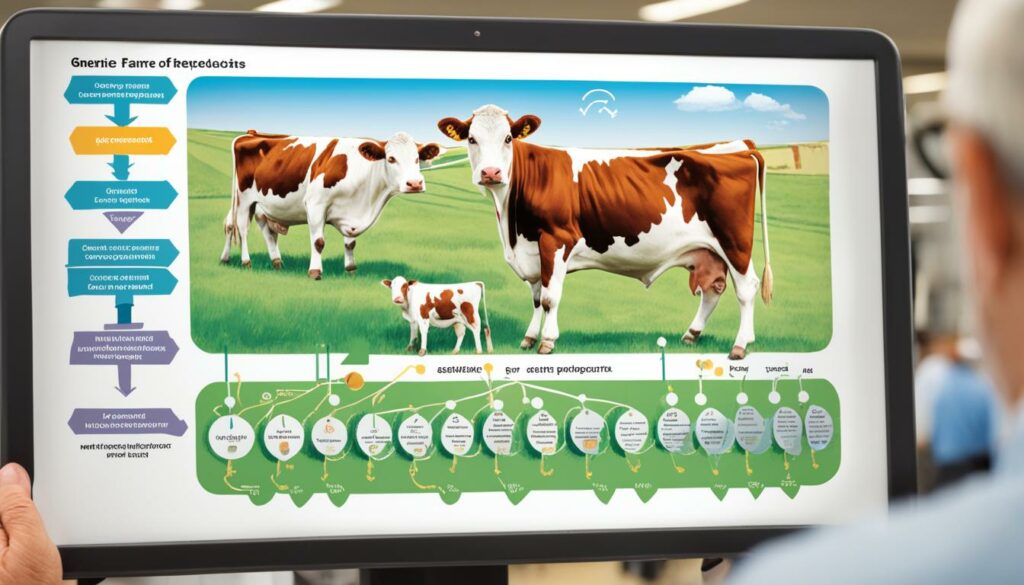
Selective breeding is key to sustainable livestock. By choosing specific traits, like strong disease resistance or better food use, we make animals healthier and more sustainable. This also means fewer harmful emissions are released.
Take dairy cows in the U.S., for example. Even though the number of cows has dropped, milk production has gone up. This shows how effective selective breeding can be.
Advanced technologies, like genetic engineering, have a big role. These include methods that help pick out the best animal traits for sustainable farming. They’ve boosted how well livestock is raised and its effect on the environment.
For instance, tests can find important genetic information in animals. This helps in making decisions that lead to healthier livestock. There’s also technology that can choose the genetic sex of animals before they’re born. This helps farms run more smoothly.
Thanks to these genetic developments, farming is becoming more eco-friendly. It uses less water, creates less methane, and needs fewer antibiotics. Using genetic techniques can help us have a stronger and more sustainable future in farming.
Traditional livestock farming has a big environmental footprint. But, we’re finding new ways using plant-based diets and cultured meat. These ways can hugely lessen the harm on our planet.
Switching to plant-based diets would mean we need much less land, down from 4 billion to 1 billion hectares. Foods from plants are also way better for the Earth, creating fewer greenhouse gases. A great example is the Beyond Meat’s Beyond Burger. It uses much less water, land, and produces fewer bad emissions than beef.
Making this change also helps combat problems like water scarcity and danger to sea life, mainly caused by making beef.
Cultured meat is also a cool new idea to lessen our need for normal farming. It helps stop deforestation and lowers the gases causing global warming. Achieving the climate goals of 1.5° and 2°C is important, and switching from animal to plant protein, which includes cultured meat, really helps. Evidence from Harwatt H. (2019) shows this shift is key for our climate. Other studies by Goldstein B. et al. (2017) and Detzel A. et al. (2021) point out the benefits of cultured meat. They say it can reduce health problems linked to bad air and cut down on water pollution.
The push for alternative proteins shows we’re making good progress. Whether it’s through plant-based diets or cultured meat, we’re on the right track to lessen the bad from livestock farming. These changes are a big step in keeping our planet safer and our food more sustainable.
Environmental conservation in livestock farming is essential. It helps keep our planet in balance and keeps our farms productive. There’s a big push to cut down deforestation and protect different plant and animal species. This is done by using farming methods that don’t harm the environment.

Expanding livestock farming often meant cutting down forests. This caused a lot of harm. But, by using sustainable grazing practices, we can stop or reduce this damage. For example, in Colombia, changing old farms into eco-friendly ones has helped prevent over a million tons of harmful gases from going into the air. This shows us how farming can help fight climate change and protect forests.
| Project | Region | Achievements |
|---|---|---|
| Sustainable Livestock Development Program | Kazakhstan | Reduction in GHG emissions |
| Bank-Supported Projects | Ethiopia and Bangladesh | Climate co-benefits funding: US$108.8M & US$259M |
| CO2 Emissions Reduction | Mexico | Reduction by 3,388,670 tons |
Keeping biodiversity is key in farming. It saves local plants and animals and keeps the land healthy. A project in Uruguay is showing how this can be done. They focus on keeping and planting more trees, saving energy, and protecting the soil. Also, the FAO helps countries use better farming ways. This helps look after nature and keeps farms healthy too.
Better herd management is key to sustainable farming and using data for decision-making. With new technology, we can improve how we look after, feed, and breed animals.
To manage a herd well, we start with good data. With sensors that monitor health and eating, farmers can ensure their animals are healthy and productive. They use cameras and microphones to study how animals behave, helping to feed them right.
These new methods cut waste and make farms more productive. The Food and Agriculture Organization says careful animal care can reduce emissions by 30%. In Scotland, treating cow and sheep diseases better has cut emissions by 4.5%. This shows that smart farming helps the environment.
Improving what we feed our animals is also crucial. Adding certain things to their diet can make them produce less methane. For example, sunflower seeds cut methane by a third. Using leftover food like sugar beet molasses also helps lower emissions.
“Supplements that reduce methane production in dairy cows, such as 3-NOP, have been found to lower methane production by up to 30%.”
Thanks to new ideas and good care, livestock farming is becoming more efficient. For instance, better managing grazing lands has boosted the quality of food for animals on over 60,000 hectares. This has directly helped 390 small farms and many more indirectly. It shows how managing land well can help both nature and farmers.
| Statistics | Impact |
|---|---|
| Emission reduction by adopting best practices | 30% |
| Emission savings in Scotland via better disease treatment | 4.5% |
| Methane reduction by sunflower seeds in diet | 33% |
| Improved forage from pasture management | 60,700 hectares |
| Directly impacted smallholder households | 390 |
| Indirectly impacted smallholder farmers | 5,800 |
In Texas, the A&M AgriLife team is pioneering high-tech farming. They use sensors and AI to watch over animals, aiming to set a new standard in caring for livestock. This work shows the big advantages of using the latest technology in farming, pushing for a more sustainable future.
Sustainable livestock farming is good for the planet and for us; it also brings big economic gains. It makes farm products more appealing in the market. And it ensures farming stays economically strong. Plus, it cuts down on costs thanks to improved ways of working.
“Livestock contributes 40% of the global value of agricultural output and supports nearly 1.3 billion people for their livelihoods and food security.”
The money benefits of sustainable farming are many. For example, cutting down on methane, a big greenhouse gas, helps the environment and makes things more efficient. This means lower costs with waste and better productivity. Sustainable ways also help avoid bad effects on land and water, keeping farming strong for the future.

With a 20% rise in the global demand for animal products coming, sustainable farming is key for growth. It helps farmers stay ahead in the market. Also, healthier animals, needing less medicine and chemicals, produce better goods. And people are ready to pay more for these quality products.
Using the latest tech for feeding animals can save resources and lower waste. This way, it supports a strong farming economy by working better and avoiding problems.
| Aspect | Traditional Livestock Farming | Sustainable Livestock Farming |
|---|---|---|
| Operational Costs | High due to inefficiencies | Reduced through efficiency gains |
| Market Appeal | Limited appeal due to environmental concerns | High appeal for sustainably-produced goods |
| Environmental Impact | Significant deforestation and emissions | Mitigated through sustainable practices |
| Animal Health | Increased reliance on antibiotics | Healthier animals with fewer chemicals |
| Long-term Viability | Threatened by resource depletion | Enhanced by ecological balance |
In summary, sustainable farming boosts the economy by offering new income streams, cutting costs, and making products more wanted. The financial gains from this method are essential for a strong future in farming.
Choosing sustainable ways to manage animals is key in the fight against big issues like feeding the world, the changing climate, and keeping our earth healthy. This is vital, as animals make up 40% of what is found in farms across the globe. They help feed about 1.3 billion people.
Yet, these animals also cause a lot of harm to our planet. They create one seventh of all the harmful gases that come from human actions. But we now have new methods to make this better.
One way is by letting animals graze in different fields and by finding better ways to deal with their waste. This helps cut down on a gas called methane that they produce the most. Also, smart ways of helping animals breed mean we don’t need as many for meat and milk.
By encouraging people to eat more plant-based foods and looking for new types of protein, we can help the planet. The choices we make about what we eat can have a huge impact. Be it for our health, for the love of animals, or the earth, it’s a move that matters a lot.
Sustainable livestock management means using eco-friendly farming. It includes caring for animals well. This leads to better, greener ways of producing food.
Healthy animals help a farm to work efficiently and reduce harm to the environment. When animals stay well, they produce less harmful gases.
Changing what animals eat can make a big difference. For example, adding things like sugar beet molasses to feed can lower gas and air pollution. Fats from tallow or sunflower oil also cut down on harmful emissions.
Some products can lower how much methane dairy cows make by over 30%. Scientists are also looking at vaccines to stop certain microbes that cause methane. This work is happening in New Zealand.
Today, we use smart sensors and AI to check on animals’ health and eating. This helps farmers work better while taking good care of their animals.
It also means less waste and pollution on the farm.
Using things like compost and giving leftovers to animals helps to manage waste. Smarter watering methods save water. All these efforts protect the environment.
Treating animals well is good for them and for us. It helps keep them healthy, happy, and less stressed. This is good for the environment too.
Breeding animals to be stronger and healthier can make farms better for the planet. It helps produce more food with fewer bad impacts.
Plant-based diets and lab-grown meats use fewer animals and resources. They also help cut down pollution and preserve forests.
Letting animals graze carefully and growing trees where they roam can stop forests from being cut down. This keeps nature in balance and helps both farms and wildlife.
Using data and technology for animal care is a great idea. It makes farms run better, saves money, and keeps animals healthier.
Farming in a way that’s good for the planet can earn more money. It saves farm costs, makes products more appealing, and helps farming be strong over time.